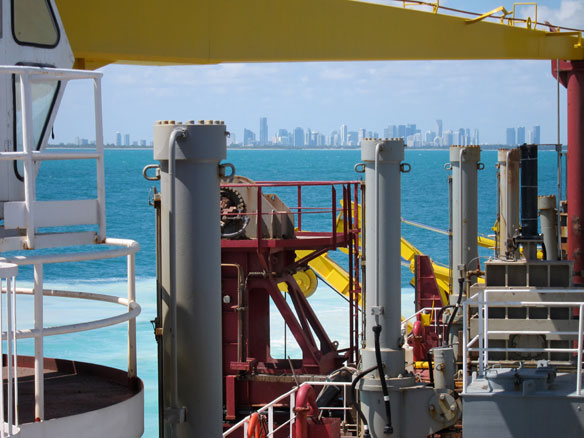
On-board a sand dredger, offshore Miami.
“Sand is the second most consumed natural resource, after water. The construction-building industry is by far the largest consumer of this finite resource. The traditional building of one average-sized house requires 200 tons of sand; a hospital requires 3,000 tons of sand; each kilometer of highway built requires 30,000 tons of sand… A nuclear plant, a staggering 12 million tons of sand…” Captions and Photograph by “Sand Wars” Filmmaker: © Denis Delestrac
Excerpts;
Between 1995 and 2002, the U.S. federal government spent $787 million on beach nourishment and has historically subsidized two-thirds of total nourishment costs to coastal communities.
As seas rise and storms surge, replenishment costs rise. “The sand used to fortify beaches has also become something of a precious commodity, shockingly expensive and difficult to mine and move.”
Researchers found “that a sudden removal of federal nourishment subsidies, as has been proposed, could trigger a dramatic downward adjustment in coastal real estate, analogous to the bursting of a bubble.”
Replenishment is a losing battle, and it’s becoming more and more expensive…
Read Full Article, ThinkProgress
Climate Adaptation and Policy-Induced Inflation of Coastal Property Value, PlosOne (03-25-2015)
Human population density in the coastal zone and potential impacts of climate change underscore a growing conflict between coastal development and an encroaching shoreline. Rising sea-levels and increased storminess threaten to accelerate coastal erosion, while growing demand for coastal real estate encourages more spending to hold back the sea in spite of the shrinking federal budget for beach nourishment. As climatic drivers and federal policies for beach nourishment change, the evolution of coastline mitigation and property values is uncertain…
Endless Erosion Battle a Matter of Money, The St Petersburg Tribune (07-21-2014)
A Beach Project Built on Sand; By Robert S. Young, PhD, in The New York Times (08-22-2014)
Climate Change Concerns Weigh On Cape Home-Buying Decisions, Boston Globe (09-22-2014)
Increased awareness of rising sea levels, flood zones, and storm surge have potential buyers rethinking how close a relationship they want with the ocean…
Palm Beach Mid-Town Dredge Project, A Video (02-04-2015)
From Coast To Coast, Vanity Fair (07-23-2013)
At opposite ends of the country, two of America’s most golden coastal enclaves are waging the same desperate battle against erosion…
Reuters’ Water’s Edge Report – Part I And Part II (09-19-2014)
Waikiki Beach Eroding Less Than A Year After $2.2M Sand Restoration, Pacific Business News (01-24-2013)
A section of Hawaii’s famed Waikiki Beach is starting to erode, less than a year after the completion of a $2.2 million project to replenish the sand on about 1,730 feet of shoreline that had been suffering from chronic erosion.
Let’s Talk About Sand: Denis Delestrac At TEDxBarcelona
The Deadly Global War for Sand, WIRED (03-26-2015)
Sand Wars, An Investigation Documentary, By Denis Delestrac
Is sand an infinite resource? Can the existing supply satisfy a gigantic demand fueled by construction booms? What are the consequences of intensive beach sand mining for the environment and the neighboring populations…? This investigation takes us around the globe to unveil a new gold rush and a disturbing fact: the “Sand Wars” have begun…








